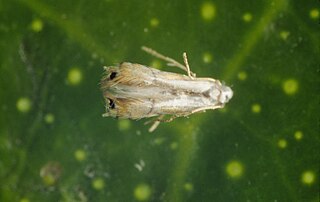Related Research Articles

Bluetongue disease is a noncontagious, insect-borne, viral disease of ruminants, mainly sheep and less frequently cattle, goats, buffalo, deer, dromedaries, and antelope. It is caused by Bluetongue virus (BTV). The virus is transmitted by the midges Culicoides imicola, Culicoides variipennis, and other culicoids.

The highland midge is a species of small flying insect, found across the Palearctic in upland and lowland areas. In the north west of Scotland and northern Wales the highland midge is usually very prevalent from late spring to late summer. Female highland midges are well known for gathering in clouds and biting humans, though the majority of the blood they obtain comes from cattle, sheep and deer. The bite of Culicoides is felt as a sharp prick. It is often followed by irritating lumps that may disappear in a few hours or last for days, depending on the individual.

A midge is any small fly, including species in several families of non-mosquito Nematoceran Diptera. Midges are found on practically every land area outside permanently arid deserts and the frigid zones. Some midges, such as many Phlebotominae and Simuliidae, are vectors of various diseases. Many others play useful roles as prey items for insectivores, such as various frogs and swallows. Others are important as detritivores, participating in various nutrient cycles. The habits of midges vary greatly from species to species, though within any particular family, midges commonly have similar ecological roles.

Sandfly is a colloquial name for any species or genus of flying, biting, blood-sucking dipteran (fly) encountered in sandy areas. In the United States, sandfly may refer to certain horse flies that are also known as "greenheads", or to members of the family Ceratopogonidae. Outside the United States, sandfly may refer to members of the subfamily Phlebotominae within the Psychodidae. Biting midges (Ceratopogonidae) are sometimes called sandflies or no-see-ums. New Zealand sandflies are in the genus Austrosimulium, a type of black fly.

Culicoides imicola is a species of biting midges that transmits the bluetongue virus (BTV) and the African horse sickness virus. This particular species has been recorded in Africa, Asia and Europe. African midges feed on animal blood, including horse, cattle, and sheep. Unlike other species within the Culicoides genus, this species prefers drier habitats for egg laying but retains a preference for moist soil to support larvae growth. Other suspected BTV vectors are Culicoides (Culicoides) pulicaris and species in the Culicoides (Avaritia) obsoletus complex.

Bombykol is a pheromone released by the female silkworm moth to attract mates. It is also the sex pheromone in the wild silk moth. Discovered by Adolf Butenandt in 1959, it was the first pheromone to be characterized chemically.

Ceratopogonidae is a family of flies commonly known as no-see-ums, or biting midges, generally 1–3 mm in length. The family includes more than 5,000 species, distributed worldwide, apart from the Antarctic and the Arctic.

The genus Orbivirus is a member of the Reoviridae family, in the subfamily Sedoreovirinae. Unlike the other reoviruses, orbiviruses are arboviruses. This genus currently contains 22 species and at least 130 different serotypes. Orbiviruses can infect and replicate within a wide range of arthropod and vertebrate hosts. Orbiviruses are named after their characteristic doughnut-shaped capsomers.

African horse sickness (AHS) is a highly infectious and deadly disease caused by African horse sickness virus. It commonly affects horses, mules, and donkeys. It is caused by a virus of the genus Orbivirus belonging to the family Reoviridae. This disease can be caused by any of the nine serotypes of this virus. AHS is not directly contagious, but is known to be spread by insect vectors.
Epizootic hemorrhagic disease (EHD) is a hemorrhagic disease of white-tailed deer caused by an infection of a virus from the genus Orbivirus subsequently called Epizootic hemorrhagic disease virus (EHDV). It is an infectious, and sometimes fatal, virus that is characterized by extensive hemorrhages, and is found throughout the United States. Large-scale outbreaks in wild ruminants affect livestock and the production industry. EHD has been found in some domestic ruminants and many species of deer including white-tailed deer, mule deer, and pronghorn antelope. Seropositive black-tailed deer, fallow deer, red deer, wapiti, and roe deer have also been found, which essentially means that they were exposed to the disease at some time in the past, but may not be involved in transmission. Outbreaks of EHD have been reported in cattle, although it is rare for them to develop disease or die. Sheep may develop clinical signs; however, this is also rare. EHD is often called bluetongue, but this is incorrect. Bluetongue virus is closely related to EHDV, and has similar clinical signs, but it is a different disease. Bluetongue is a serious disease in cattle, as well as other ruminants, and can have a significant effect on international trade. Testing at animal health laboratories is necessary to distinguish between the viruses that cause bluetongue and EHD.
Sex pheromones are pheromones released by an organism to attract an individual of the opposite sex, encourage them to mate with them, or perform some other function closely related with sexual reproduction. Sex pheromones specifically focus on indicating females for breeding, attracting the opposite sex, and conveying information on species, age, sex and genotype. Non-volatile pheromones, or cuticular contact pheromones, are more closely related to social insects as they are usually detected by direct contact with chemoreceptors on the antennae or feet of insects.

Culicoides is a genus of biting midges in the family Ceratopogonidae. There are over 1000 species in the genus, which is divided into many subgenera. Several species are known to be vectors of various diseases and parasites which can affect animals. Like Leptoconops, the genus has a long fossil record, with earliest known fossils being from the Burmese amber, around 99 million years old.

The citrus leafminer is a moth of the family Gracillariidae. It is also known as CLM in agriculture. It was first found in Florida in 1993, but is now found all over the world, including Argentina, Australia, Brazil, China, Corsica, Costa Rica, Cuba, India, Israel, Madeira, Malaysia, Mauritius, Mexico, the Philippines, South Africa, Spain Sri Lanka and other parts of the United States.

A pheromone trap is a type of insect trap that uses pheromones to lure insects. Sex pheromones and aggregating pheromones are the most common types used. A pheromone-impregnated lure, as the red rubber septa in the picture, is encased in a conventional trap such as a bottle trap, Delta trap, water-pan trap, or funnel trap. Pheromone traps are used both to count insect populations by sampling, and to trap pests such as clothes moths to destroy them.

Anna Levinson was a German zoologist who specialized in general and applied entomology. She worked at the Max Planck Institute for Behavioral Physiology from 1971, and at the Max Planck Institute for Ornithology from 2004 in Seewiesen and Erling.
Dr. Simon Carpenter, Head of the Entomology and Modelling Group in the Vector-borne Diseases Programme at the UK Biotechnology and Biological Sciences Research Council Institute for Animal Health’s Pirbright Laboratory in Woking, Surrey, is an entomologist who was awarded the first Rooker Prize in 2009 in recognition of his research on biting midges that transmit bluetongue virus (BTV), the causative agent of bluetongue disease, an important orbivirus disease of ruminants.
Epizootic hemorrhagic disease virus, often abbreviated to EHDV, is a species of the genus Orbivirus, a member of the family Reoviridae. It is the causative agent of epizootic hemorrhagic disease, an acute, infectious, and often fatal disease of wild ruminants. In North America, the most severely affected ruminant is the white-tailed deer, although it may also infect mule deer, black-tailed deer, elk, bighorn sheep, and pronghorn antelope. It is often mistakenly referred to as “bluetongue virus” (BTV), another Orbivirus that like EHDV causes the host to develop a characteristic blue tongue due to systemic hemorrhaging and lack of oxygen in the blood. Despite showing clinical similarities, these two viruses are genetically distinct.

Tibrovirus is a poorly characterized genus of viruses in the family Rhabdoviridae, order Mononegavirales. As of 2019, there are 8 members of the tibrovirus genus. Tibroviruses have been isolated from biting midges, cattle, and humans. None of the tibroviruses, except for Bas-Congo virus, have been associated with any diseases.

Many species of flies of the two-winged type, Order Diptera, such as mosquitoes, horse-flies, blow-flies and warble-flies, cause direct parasitic disease to domestic animals, and transmit organisms that cause diseases. These infestations and infections cause distress to companion animals, and in livestock industry the financial costs of these diseases are high. These problems occur wherever domestic animals are reared. This article provides an overview of parasitic flies from a veterinary perspective, with emphasis on the disease-causing relationships between these flies and their host animals. The article is organized following the taxonomic hierarchy of these flies in the phylum Arthropoda, order Insecta. Families and genera of dipteran flies are emphasized rather than many individual species. Disease caused by the feeding activity of the flies is described here under parasitic disease. Disease caused by small pathogenic organisms that pass from the flies to domestic animals is described here under transmitted organisms; prominent examples are provided from the many species.
Sarah Wanless is an animal ecologist in the UK and is an expert on seabirds; she is a Fellow of the Royal Society of Edinburgh and is Honorary Professor at the Universities of Glasgow and Aberdeen.
References
- ↑ "Jennifer Mordue - Scotland Group". www.soci.org. Retrieved 2019-12-15.
- ↑ Correspondent, By Gillian Harris, Scotland (2003-03-01). "Scientists bite back in war on midges". The Times. ISSN 0140-0460 . Retrieved 2019-12-15.
- ↑ "Larger people 'more likely to suffer midges attack'". The Independent. 2010-07-28. Retrieved 2019-12-15.
- ↑ McIlroy, Emma. "Midge pheromone may set sex trap". New Scientist. Retrieved 2019-12-15.
- ↑ "BBC - Scotland Outdoors Articles - Bluetongue". www.bbc.co.uk. Retrieved 2019-12-15.
- ↑ "Jennifer Mordue - Scotland Group". www.soci.org. Retrieved 2019-12-15.